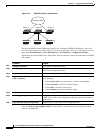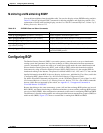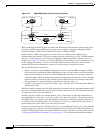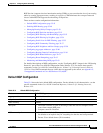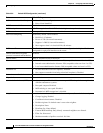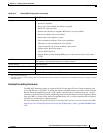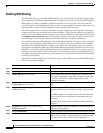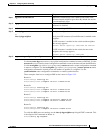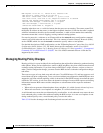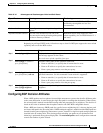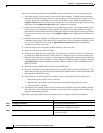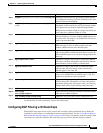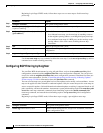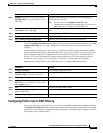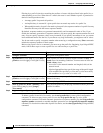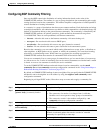
35-50
Cisco ME 3400 Ethernet Access Switch Software Configuration Guide
OL-9639-06
Chapter 35 Configuring IP Unicast Routing
Configuring BGP
BGP neighbor is 129.213.1.1, remote AS 200, external link
BGP version 4, remote router ID 175.220.212.1
BGP state = established, table version = 3, up for 0:10:59
Last read 0:00:29, hold time is 180, keepalive interval is 60 seconds
Minimum time between advertisement runs is 30 seconds
Received 2828 messages, 0 notifications, 0 in queue
Sent 2826 messages, 0 notifications, 0 in queue
Connections established 11; dropped 10
Anything other than state = established means that the peers are not running. The remote router ID is
the highest IP address on that router (or the highest loopback interface). Each time the table is updated
with new information, the table version number increments. A table version number that continually
increments means that a route is flapping, causing continual routing updates.
For exterior protocols, a reference to an IP network from the network router configuration command
controls only which networks are advertised. This is in contrast to Interior Gateway Protocols (IGPs),
such as EIGRP, which also use the network command to specify where to send updates.
For detailed descriptions of BGP configuration, see the “IP Routing Protocols” part of the Cisco IOS IP
Configuration Guide, Release 12.2. For details about specific commands, see the Cisco IOS IP
Command Reference, Volume 2 of 3: Routing Protocols, Release 12.2. See
Appendix C, “Unsupported
Commands in Cisco IOS Release 12.2(46)SE,” for a list of BGP commands that are visible but not
supported by the switch.
Managing Routing Policy Changes
Routing policies for a peer include all the configurations that might affect inbound or outbound routing
table updates. When you have defined two routers as BGP neighbors, they form a BGP connection and
exchange routing information. If you later change a BGP filter, weight, distance, version, or timer, or
make a similar configuration change, you must reset the BGP sessions so that the configuration changes
take effect.
There are two types of reset, hard reset and soft reset. Cisco IOS Releases 12.1 and later support a soft
reset without any prior configuration. To use a soft reset without preconfiguration, both BGP peers must
support the soft route refresh capability, which is advertised in the OPEN message sent when the peers
establish a TCP session. A soft reset allows the dynamic exchange of route refresh requests and routing
information between BGP routers and the subsequent re-advertisement of the respective outbound
routing table.
• When soft reset generates inbound updates from a neighbor, it is called dynamic inbound soft reset.
• When soft reset sends a set of updates to a neighbor, it is called outbound soft reset.
A soft inbound reset causes the new inbound policy to take effect. A soft outbound reset causes the new
local outbound policy to take effect without resetting the BGP session. As a new set of updates is sent
during outbound policy reset, a new inbound policy can also take effect.
Table 35-10 lists the advantages and disadvantages hard reset and soft reset.



